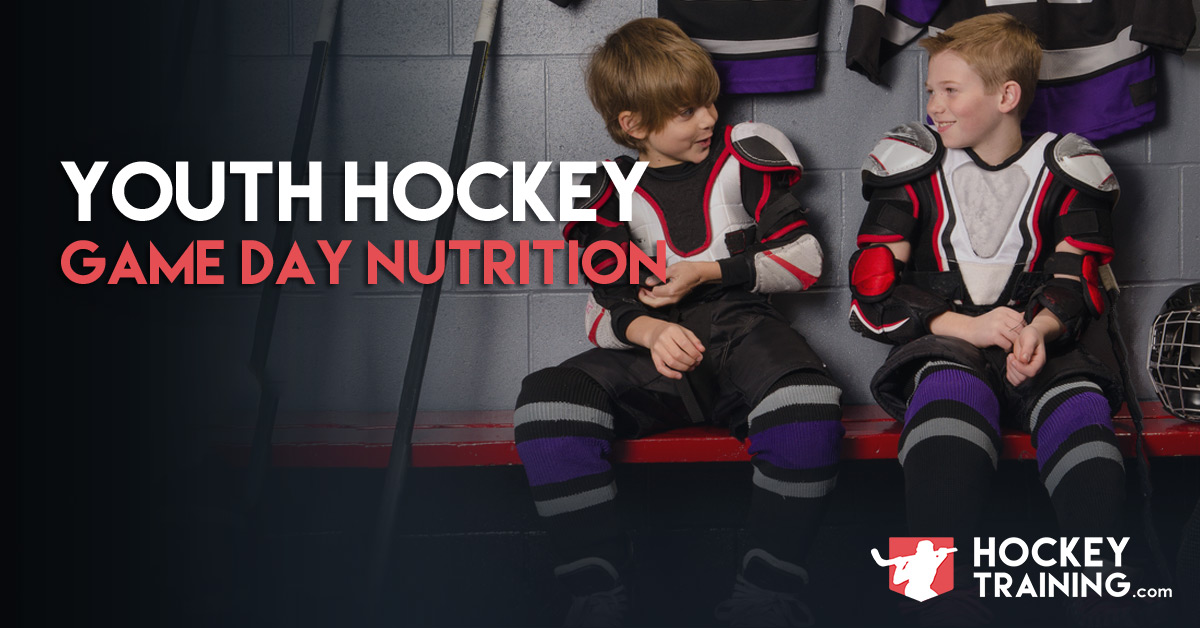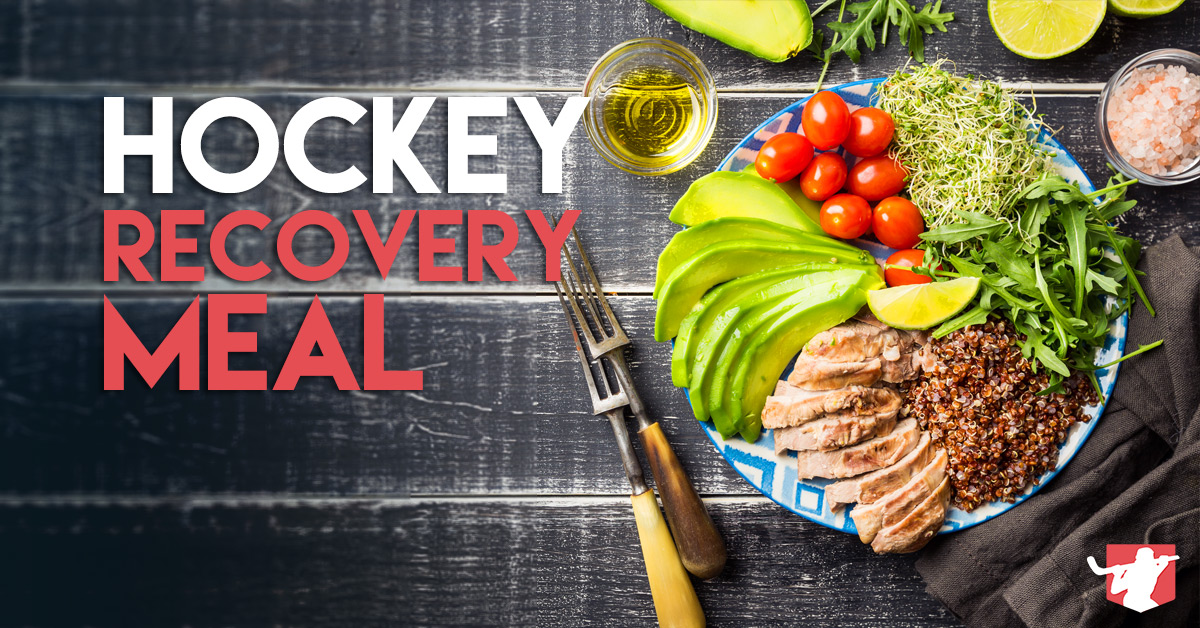What does nutrition look like for young hockey players?
In this article, I want to go over how good nutrition habits can improve hockey performance and recovery for young athletes, and briefly touch upon the health factors it’s going to provide as well.
Let’s get into it…
As I outline in the many youth hockey programs we have available here at Hockey Training, the nutritional patterns we develop in our youth serve as a foundation for how we are going to eat for life.
The behaviors, relationships, and food we eat shape our brain development, overall health, body composition, metabolism, and ability to repeatedly perform in high-energy sports like hockey.
Within the scientific literature, the top 3 sources of calories children are consuming are:
- Milk
- Juice
- Pasta
You probably don’t need me to tell you that this blog is off to a pretty rough start. Not a lean protein, fruit, or vegetable in sight.
This also isn’t mentioning the unknown number of cookies, ice cream, sugar cereals, treats at school, treats after hockey, and random candies they get during every grocery store or mall trip.
The light at the end of the tunnel here is that although this is a very poor foundation to build and perform from, it’s completely unnecessary and even not recommended to go super healthy and try to be the over-controlling parent counting their kids’ calories.
Remember, we are shaping behaviors and patterns for life here. Creating an unhealthy relationship with food where a kid is worried about their calorie intake at such a young age is the exact opposite of what we are trying to accomplish here.
Food is a positive experience that needs to be inhaled throughout life, not shunned. Think about it – whenever we gather with our friends we have tasty food, at every holiday there is a delicious meal, and for birthdays/anniversaries and everything else you can think of—we have some tasty food!
We shouldn’t feel guilty for these actions, especially if we are 8 years old.
Using exact measurement techniques, making kids aware of their body weight, force feeding them to gain weight, underfeeding them to lose weight, punishing them for going “off-track”, and many other poor nutritional strategies for athletic enhancement never work in the long run.
We are not trying to build the best athlete in the world today, we are trying to create a healthy foundation so that they can become the best athlete they can be later in life.
Not to mention, trying to count their calories is an incredibly flawed strategy as you will have no idea what their ideal intake should be during this development stage of their life.
Nutrition will impact:
- Their body fat
- Their total body weight
- Their overall health
- Their brain development
- Their puberty development
- Their hormone status
- Their muscle and bone growth as they grow
Among many, many other things…
So, incorporating some simple healthy habits without counting anything are going to go the longest way for both physical development and behavioral relationships with food.
Keep it simple.
The two things that almost every youth athlete I have worked with that pop up the most are:
- They consume too much sugar
- They consume too little protein
Because of the above two factors, kids are getting more and more overweight as the decades continue to pass on. Excellent research in these areas tells us (all statistic here are from the US):
In 1980, 7% of the kids between 6-11 were obese.
In 2010, this jumped from 7% up to 18% (almost 1 out of every 5 kids)
Now, 33% of kids are classified as obese.
These numbers are always rising and are causing hormonal disturbances and disease states we used to only ever see in middle-aged adults, let alone the obvious negative impact it has on hockey conditioning.
Cutting Back on Sugar
The strategy here is not to eliminate, but instead decrease sugar consumption and avoid your child rebelling by using tactics that make it seem like it was never there:
- Instead of cereal, make them an omelet.
- Instead of cereal, make them a breakfast smoothie.
- Instead of an imitation fruit snack, give them a banana.
- Out of sight is out of mind. Keeping cookies, ice cream, and candy in the house at all times is likely not best for either of you.
- Instead of juice or chocolate milk, opt for more water and white milk
- Instead of white bread, use wheat bread (no, the white bread that says it’s secretly wheat bread is not).
- Instead of hash browns, have a bowl of oatmeal.
- Instead of sugary yogurt, use plain Greek yogurt and add-in real berries.
In many cases, simple switches go unnoticed and become an excellent move for you to reduce the total daily sugar intake of your youth athlete.
This reduction will create more even-keeled energy levels, more even-keeled attention span, and an overall improved health and body composition.
It really just comes down to having your kids eat real food. If it doesn’t have a label or cartoon on it, you’re off to a good start.
Lowering processed foods and sugars are really the only subtractions recommended. If you can cut back processed foods and sugar by a third, you’re doing great. We aren’t looking for wild overnight changes, one small thing at a time is a huge win.
What’s more important for youth athletes is what we add, and not what we subtract.
Protein for Youth Hockey Players
For protein intake, youth athletes should be sticking to roughly 1-2 palm size servings of protein per meal (their palm size, not yours), every meal. Here are some example serving sizes of youth protein for you:
- Palm size serving of lean meat (Chicken breast, turkey breast, fish, bison, wild game)
- Palm size serving of fatty meat (Chicken thighs, steak, ground beef, ground turkey)
- 1-2 whole eggs
- ½ cup egg whites
- 3 slices of turkey bacon
- ½ cup of Greek yogurt
- ½ cup of cottage cheese
- ½ scoop whey protein powder
Ideally, they would take in this type of serving size 3-4 times per day in the form of real food. Incorporating these foods at this intake will help them burn fat, build muscle, support performance, support recovery, and support a healthy growth process going into their adolescent years.
Not to mention, protein is the most satiating (feelings of fullness) macronutrient in the nutrition world. So, when we eat protein with every meal, we don’t have room for the “add-ons” that would otherwise be present that are likely not best for our athletes.
Getting Ready for Game Day
Surprisingly, game days don’t differ too much from the everyday eating of a youth athlete, the only areas we investigate for improvement are within:
- Hydration
- Pre-game meal
- Post-game meal
For youth hydration, water, flavored water, and unsweetened tea are some of the best hydrators you can have throughout the day.
It’s highly recommended to eliminate fruit juices (or decrease their frequency) and replace them with whole fruit, and then use primarily water or another one of the above recommended beverages to meet the hydration needs.
Knowing this, how much water should our youth athletes be consuming?
- 1-Hour before exercise: ~5-8oz of water
- 15mins before exercise: ~5-8oz of water
- During exercise: ~5-8oz of water or a sports drink such as Gatorade every 20mins
- Within 2hrs after exercise: ~20-24oz of water or a sports drink
And as for the total daily intake, youth athletes vary dramatically on their needs due to the many individual variations.
So, to keep things simple and individual, their pee should be clear or slightly yellow throughout the whole day. If they’re peeing 5x throughout the day and 2x after a game, they’re doing great.
This recommendation is simple and takes care of both the intake and individual difference factors in one shot because hydration status is very accurately determined via urine color.
Pre-Game Meal
Prior to a game, your primary fuel needs to come from a solid food source.
You need something solid to be in the stomach to balance your blood sugar and food sources that are going to serve to provide your body with the raw materials required for hockey specific energy throughout the entire game.
The last thing you want is to be hungry during a hockey game. That is going to lead to lower blood sugar levels, decreased focus, decreased attention span, decreased energy, and physical weakness. Or, you know, a kid whining on the bench that he wants to go home.
A youth athlete’s typical pre-game meal should consist of a 1:1, or, 2:1 ratio of carbohydrate to protein 1-3 hours before the game.
Example of a 1:1 ratio of carbs to protein:
- 2-3oz chicken breast
- 1/2 cup of rice
- 1 cup green vegetables
Example of a 2:1 ratio of carbs to protein:
- 2-3oz chicken breast
- 1 cup of rice
- 1 cup green vegetables
The above two examples are recommendations for the average youth athlete.
Keep in mind, these numbers can change for various reasons (big kid, small kid, maybe they haven’t eaten for several hours and need more, etc.), but are a very solid general guideline to eyeball when making the pre-game meal.
If the kid is a big eater or is eating the meal more like 2-3 hours before a game, opt further towards the 2:1 end of the spectrum.
If the kid is a small eater or is eating the meal more like 1-2 hours before a game, opt closer towards the 1:1 end of the spectrum.
Post-Game Meal
The two biggest goals we are trying to accomplish within the post-workout period for youth athletes are glycogen replenishment (getting carbs back into the muscle) and increased protein synthesis (synthesis simply means to “grow” or “add”. Hence, protein synthesis representing adding protein back to your muscle tissue after it has been broken down by physical activity).
How do we accomplish these goals?
And what nutrients do we need to take in?
Well, it ends up looking very similar to our pre-game meal, but, with a little bit more protein and carbohydrates to maximally support recovery.
Starting with protein, what should you have and how much of it should you be having?
This varies from athlete to athlete depending on variables such as your age, total muscle mass, total dietary intake, the length of the game, and current fitness level.
But, a great general guideline to follow would be 10-15g of protein. In real-world measurements, this should be about 2 palm size servings (their palm) of protein post-game.
Ideally, this would be in the form of an animal source of protein as it contains a large amount of the amino acid leucine, which has been linked to maximize this protein synthetic response. Not to mention, animal proteins top the charts of nearly every single scientific protein quality ranking in existence.
Post-game carbohydrate content can vary as well depending on similar variables. Of course, a 2-hour game would yield a greater need for carbohydrates post-game than a 1-hour light practice.
Here, we still want to stick to our real food options (as opposed to processed food) and opt for options such as rice, pasta, quinoa, beans, fruit, or oatmeal as these will all go a long way towards optimal recovery and likely be a superior option post-game than drinking more Gatorade.
Gatorade can be a good thing during games, but let’s back off the consumption of further sports drinks post-game whenever we can.
Recap
Although nutrition is often overlooked as an important factor for hockey performance, it is, in fact, one of THE most important factors because if you’re not putting the right fuel in the car, you’re not going anywhere, and your engine is going to perform poorly.
For youth, keep things nice and simple:
- Have them eat real food. Avoiding products that are specifically marketed towards kids with cartoons is a great place to start.
- Eat more fruits and vegetables wherever you can for the maintenance of good health but also to get some of the important performance-based vitamins and minerals in their body. 3-5 fist-sized servings per day (their fist size) is the ideal zone you want to be in.
- Supplementing with some Omega-3’s and Whey Protein is recommended for youth hockey athletes
- Cut back on sugars, add in some protein
- Adopt healthy habits yourself. The “do as I say and not as I do” strategy will not work here. If you don’t eat well, why should they? You’re the parent here.
- Incorporate the “adding in” method of food choices as opposed to the “removing out” method of eliminating all their favorites
- On game day, follow the above strategies for optimal performance
If you’re looking to help your youth hockey player increase his or her performance on the ice check out our Youth In-Season Hockey Training Program (for players 12-14 years old) or our Bodyweight Training Program (for players of all ages)!










We have a 11yr old ice hockey player that has a eating disorder. We have tried everything to get him to stay away from carbs and when we insist on eating meat, veggies, eggs it becomes a unpleasant experience resulting in tears and gagging. As a toddler he ate well but from 6yrs forward he remarks that the voice is telling him you will not like this. Any suggestions?
Hey Bonnie,
Unfortunately working with eating disorders is something I do not specialize in and it is a true discipline all by itself, so, commenting exact strategies here would be irresponsible of me. I would recommend working with a specialist in your area, and in the meantime opt for high-protein carbohydrate foods wherever possible like quinoa and beans — and maybe even trying to make protein pancakes as it’s likely that will have a high-percentage chance of being received well.
I have a 9 year old that is playing div 1 Atom hockey and I notice he seems to tire out towards the back half of practices, seemingly more than the other kids. His water bottle is 1/3 to 1/2 Gatorade and the rest is water. Is he suffering from coming off a sugar rush because I’m giving him Gatorade? Should I just be giving him straight water?
Hey Michael,
You could try giving him straight water and see if that helps, but, I don’t think an abscence of Gatorade would allow him to be more fueled.
Instead, if you suspect a sugar crash, I would include a little more healthy fats in his pre-practice and/or pre-game meal as they are the #1 blood sugar stabilizer. A small handful of raw nuts is enough to do the trick here and is something that most kids will have no problem with.